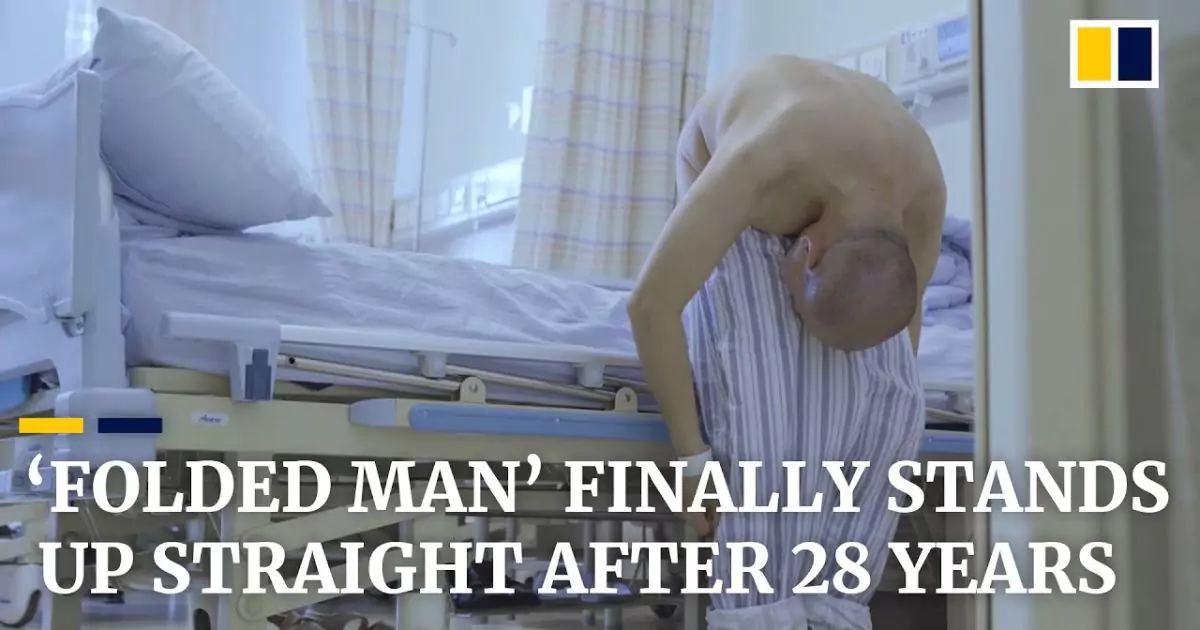Folded Man’ Stands Tall After 28 Years Following Life-Changing Surgery for Rare Disease
A man who lived with a condition that left him ‘folded over’ for years has finally had life-changing surgery after consulting with a specialist doctor. Li Hua, from China, had suffered from ankylosing spondylitis, a debilitating autoimmune disease, for nearly three decades. This condition causes the bones in the spine to fuse together, leading to severe curvature and immobility. Li first began experiencing symptoms at 18, and as the disease progressed, it became increasingly debilitating.
The Struggle with Ankylosing Spondylitis
Li Hua, from China, had suffered from ankylosing spondylitis, a debilitating autoimmune disease, for nearly three decades. This condition causes the bones in the spine to fuse together, leading to severe curvature and immobility. Li first began experiencing symptoms at 18, and as the disease progressed, it became increasingly debilitating.
.webp)
Eventually, the disease left Li completely doubled over, unable to stand up straight or even lie flat. During this time, he required full-time care from his mother, Tang Dongchen, who supported him tirelessly.
The Long Search for Treatment
For years, the family searched for a specialist who could treat Li’s condition. Despite their efforts, they struggled to find a solution that could offer Li any relief.
Li Hua before surgery. (Shenzhen University General Hospital)
A Breakthrough at Shenzhen University General Hospital
In 2020, the family’s perseverance paid off when they finally found help at Shenzhen University General Hospital. They met with Dr. Tao Huiren, a specialist who was willing to take on the challenging case.
Dr. Huiren described the complexity of the surgeries as akin to ‘scaling Mount Everest’. It took him two weeks to develop a detailed surgical plan to address Li’s condition.
The Surgeries
Li underwent four complex procedures designed to break and reconstruct his fused bones, thereby restoring some mobility to his joints and enabling him to stand up straight. These surgeries were incredibly intricate and risky, but they ultimately proved to be successful.
A New Lease on Life
Following the surgeries, Li Hua regained a significant amount of movement with the support of physical rehabilitation. He now has 20 pins in his neck, which limits his ability to move it, but his overall mobility has dramatically improved.
Li Hua after the surgery. (Shenzhen University General Hospital)
A Dramatic Improvement
Despite his continued need for assistance from his mother to stand up, lie down, and perform certain daily activities, Li is grateful for the improvement in his condition. Speaking to the South China Morning Post in 2020, he expressed his relief and newfound hope:
“I’ve been doing the rehabilitation exercises at home in the past few months. Now I can walk slowly with the walking frame, go to the sink, brush my teeth, and wash my face. I can hold a bowl and eat like anyone else, sitting at the table. I’m happy – I have hope.”
His mother, Tang Dongchen, shared her determination to support her son:
“I wasn’t going to give up on my son. I gave birth to him, so I had to try my best to find a way to make him better. Otherwise, when I die, who will look after him?”

The Ongoing Battle with Ankylosing Spondylitis
While there is no complete cure for ankylosing spondylitis, the surgery has significantly improved Li’s quality of life. He can now stand up straight and walk with the aid of a stick. The surgeries and subsequent rehabilitation have given him a level of independence that he had not experienced in years.
Understanding Ankylosing Spondylitis
Ankylosing spondylitis is a chronic inflammatory disease that primarily affects the spine, leading to severe, long-term pain and disability. The inflammation can cause some of the vertebrae in the spine to fuse together, resulting in a rigid and immobile spine. This fusion process can also affect other parts of the body, including the hips, shoulders, and knees.
Symptoms and Diagnosis
The symptoms of ankylosing spondylitis typically begin in early adulthood and can vary widely from person to person. Common symptoms include chronic back pain and stiffness, which are often worse in the morning and after periods of inactivity. As the disease progresses, it can lead to a hunched-forward posture, difficulty breathing due to limited chest expansion, and chronic fatigue.
Diagnosis is usually made based on a combination of medical history, physical examination, imaging tests such as X-rays or MRIs, and blood tests to check for markers of inflammation.
Treatment and Management
While there is no cure for ankylosing spondylitis, there are several treatment options available to manage symptoms and improve quality of life. These include:
- Medication: Nonsteroidal anti-inflammatory drugs (NSAIDs) are often the first line of treatment to reduce pain and inflammation. In more severe cases, biologic medications that target specific inflammatory pathways may be prescribed.
- Physical Therapy: Regular physical therapy is crucial for maintaining mobility and flexibility. Exercises that focus on stretching, strengthening, and improving posture can help manage symptoms and prevent further progression of the disease.
- Lifestyle Modifications: Maintaining a healthy lifestyle, including regular exercise, a balanced diet, and good posture, can help manage symptoms and improve overall well-being. Smoking cessation is also important, as smoking can worsen the symptoms of ankylosing spondylitis.
- Surgery: In severe cases, surgery may be necessary to correct deformities, relieve pain, and improve function. Surgical options include joint replacement, spinal fusion, and osteotomy, which involves cutting and realigning bones.
The Importance of Early Intervention
Early diagnosis and intervention are crucial for managing ankylosing spondylitis effectively. By starting treatment early, patients can slow the progression of the disease, reduce pain and stiffness, and maintain a higher quality of life. Regular monitoring and follow-up with a healthcare provider are essential to ensure that the treatment plan is working and to make any necessary adjustments.
Support and Resources
Living with ankylosing spondylitis can be challenging, but there are resources and support available to help patients and their families. Support groups, online communities, and patient advocacy organizations can provide valuable information, emotional support, and practical advice for managing the disease.
Final Thoughts
Li Hua’s journey from being ‘folded over’ to standing up straight after 28 years of suffering from ankylosing spondylitis is a testament to the power of perseverance and the advancements in medical science. His story highlights the importance of seeking specialized care and the impact that dedicated healthcare professionals can have on patients’ lives.

While Li’s condition is not completely cured, the surgeries have significantly improved his quality of life, allowing him to perform daily activities with greater independence. His experience serves as an inspiration to others living with chronic conditions, reminding them that there is always hope and that with the right treatment and support, it is possible to overcome even the most challenging obstacles.
As we continue to make strides in medical research and treatment, stories like Li Hua’s give us hope for a future where more people can find relief from debilitating conditions and enjoy a better quality of life.

